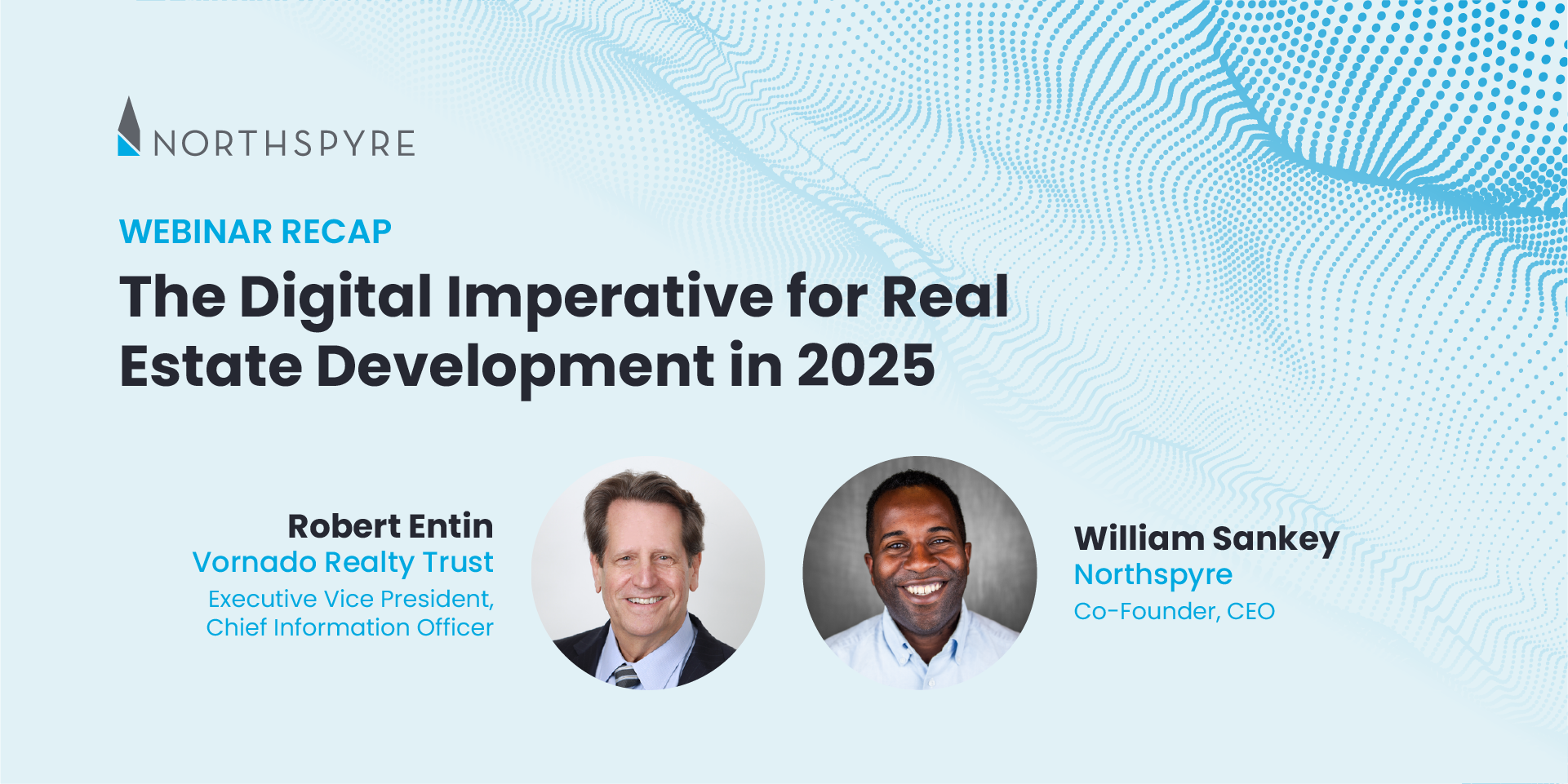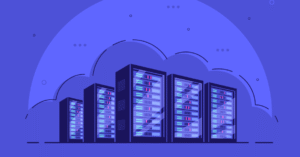Northspyre hosted a webinar exploring “The Digital Imperative for Real Estate Development in 2025” in January. In the webinar, Northspyre Co-Founder and CEO William Sankey and Vornado Realty Trust CIO Robert Entin had a wide-ranging discussion about how developers can navigate digital transformation, Vornado’s personal digital transformation journey, and guidance on how to influence decision-making and drive change within your organization.
Here’s a closer look at some key points from the webinar, including insights and key takeaways from the conversation.
Understanding the Rise of PropTech In CRE Development
William and Robert both have extensive backgrounds in development and PropTech. As an NYC developer, William led high-profile, multi-million dollar developments with prominent firms including Madison Realty Properties and JLL. Before joining Vornado, Robert founded Integrated Business Systems, providing turnkey technology solutions to the real estate industry. He is both a thought leader in the industry and an adjunct professor at Columbia University teaching a master’s course on IT & the Real Estate Enterprise.
William and Robert began the conversation by discussing the maturation of PropTech over the last decade. Robert shared his perspective on the factors leading to the industry’s digital shift. “The tech stack running the corporate and accounting side of real estate has been out there and mature for many years,” he said, “but in the last decade, and accelerating every year, the advent of the smartphone and apps changed users understanding of what software can do and how to leverage technology to increase the efficiency of tasks.” He also attributed the growing prevalence of PropTech to the rise of technology integration in physical properties for sustainability and tenant services.
Robert also shared what a comprehensive tech stack looks like for Vornado’s development operations, as the firm is behind a vast portfolio of Class A buildings in New York City. In order to keep Vornado’s properties status as Class A buildings, the firm invests in tenant improvements, fittings, core and shell upgrades, and more improvements regularly. Roberts says automating budgeting, bidding, contract management, and tracking job costs is essential for running the business in such a cost-intensive field. Vornado’s development group, in charge of new buildings and a separate operation from in-house TI and capex management, implemented Northspyre to have a platform suitable for not just internal management but also allowing for external stakeholders to take part.
Tips for Implementing Broader Digital Transformation
Vornado’s tech stack and internal structure allows the firm to instigate and maintain an ambitious portfolio of projects. William asked Robert what tips he might give for firms newer to bringing on technology to facilitate operations and what the firm looks for when searching for new tools. He emphasized how finding a tool with the correct functionality could be a game changer. “Our search was spurred by the notion that we needed a platform that could be a good extranet, one that we could participate in as well as stakeholders could participate in, because shared information on a large development project is critical,” Robert said.
He noted the development space is divided into owners or managers, construction managers, and contractors, and the software stack needs to satisfy all users’ needs. Owners, he noted, need more ability to look at the problem holistically. “We were looking for a platform that provided, for one, good document management, good inbound processing of various invoices, contracts, and was easily shareable among the various stakeholders,” he said, “so we liked Northspyre because we thought it was a nice user interface, easy to operate, and easy to drill into and find the details of the world.”
When discussing how a company can best decide on a software product, Robert noted a full suite of products might offer an easier job with integration without a full rich feature set. He used the analogy of a decathlete, who might do well in each individual event but not win at any, whereas a specialist will be successful in a respective field. In other words, for each task or use case, development firms must choose between a best-of-breed tool with advanced features and benefits, or if the task can be managed by the more generalized tools otherwise available in the tech stack.
Do Development Teams Need Robust Tech Talent In-House?
Robert explained how Vornado is unique in having a robust IT and tech team in-house to address needs as they come up. He noted that building tools in terms of software is generally reserved for basic needs, while bigger lift tasks may need to be outsourced to a third-party tool. Vornado is lucky to have a robust tech team, but Robert explained there are many talented contractors and specialists available to their development teams, and the culture of the company should determine what kind of tech operations to do in-house.
William also asked what the benefit in terms of ROI is for businesses bringing tech talent on board. Robert said a business driver for bringing external partners and external reporting feeds and accessibility to project data was the biggest driver for bringing on a tool like Northspyre. “The driver for us was getting a platform that could drive and surface all the myriad pieces of information around a large piece of development, that would make it easy for people at any level to understand draw for draw, where we are in the project and the budget,” Robert said. He also noted bringing on the platform led to other tangential efficiencies, such as an automated process for inbound invoicing.
Development can be an old-school industry, and William asked how to approach digital transformation from a business culture point of view. Robert reiterated transformation has to come from the top and be transmitted by executive leadership. He says it’s important to evaluate where the staff is, as some individuals may be more ready for change than others. “All cultures move, and now are moving more and more toward understanding automation,” Robert also said, “it’s something more endemic.”
Executive leadership sets the tone in terms of digital transformation, and that messaging becomes the motivation to the team for adapting to where the team will be in the future. Robert made a point to note how communicating to team members automation helps do more value-based work can be essential for combatting resistance. “That’s the good news – when people do a menial task they used to do or spend a lot of time doing cut in half or eliminated, certainly that’s helpful,” he said.
Question & Answer Session
Robert and William also took time at the end of the webinar to take questions from audience members. Here are some of the pressing questions on attendees’ minds:
What advice do you have for developers starting a PropTech Journey?
Robert suggested looking for areas that need the most attention. If developers are looking at all the tasks that need to be facilitated, it’s important to acknowledge the tasks can’t all get done at once. Prioritize areas of the business and operation that will be improved the most by automation. He also suggested developers take a good amount of time to select the most comprehensive solution. “Spend more time than you think you need selecting a product,” Robert said. “Kick the tires, and make sure the product does what you think it’s going to do. The more time you take upfront the less surprise you’ll have once you implement.”
What are lessons or mistakes that could be helpful for others?
Robert said, as a software developer, he brought most of the solutions to the business and encouraged adoption. “At the end of the day, it’s not about the technology, it’s about the adoption across the team,” he said. He said look for what tools are being used with enthusiasm in the business and use this information to inform decision making.
When you’re evaluating new technology, what are key considerations around integrations teams should prioritize?
“Integrations aren’t easy,” Robert said, “so the first consideration should be whether or not the third-party solution is robust enough that your team really wants it.” Robert said once deciding to do an integration consider how complicated the implementation will be – is it one-way, two-way, or otherwise. He also said it’s important to ensure the product has the appropriate API’s or interface standards to allow for an integration to be successful.
Watch the full webinar on-demand now and learn more about how digital transformation can help your CRE business deliver value in agile, scalable ways.



